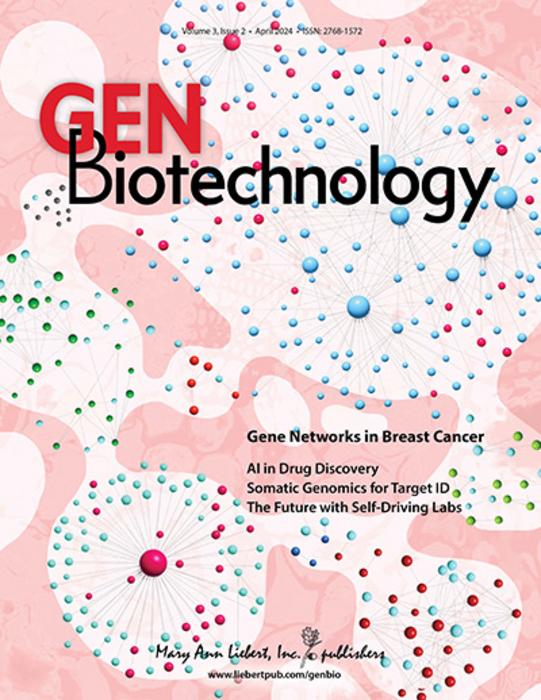New Rochelle, NY, June 24, 2024—A new study published in the current issue of the peer-reviewed journal GEN Biotechnology describes the establishment of the first hydrogel-based platform for producing T-cells from hematopoietic stem and progenitor cells. Researchers engineered biomaterials integrated with key thymic components to direct T-cell development, producing functional T-cells with the capability for cytokine production. Click here to read the article now.
Peter Zandstra, from the University of British Columbia, and coauthors of this study state that combining these 3D-engineered hydrogels with cell-based gene therapy could enhance CAR T-cell potency in cancer treatments.
Also featured in the latest issue of GEN Biotechnology is the article titled “Reducing Excessive Fat Accumulation Using Deoxycholate-Based Composite Microparticles.” Solubilized deoxycholic acid has been FDA-approved and used commercially for local fat reduction; however, injection site reactions have limited its success in the clinic. Lola Eniola-Adefeso, from the University of Michigan, and colleagues, reported that optimizing the dosage of deoxycholate-based composite microparticles can significantly reduce fat in a mouse model without causing any visible injection site reactions. The authors also demonstrate the scalability of the particle treatment by modulating the number of injection sites to achieve a well-tolerated, significant fat reduction in a larger rodent model.
In the Perspective article titled “Neural Network Potentials for Advanced Small-Molecule Drug Discovery and Design,” Simon Barnett, from Dimension, describes the merger of key computational technologies such as molecular mechanics force fields and machine learning, in the form of neural network potentials, as a new frontier for rapid, accurate and generalizable small-molecule drug discovery.
Advances in spatially resolved and high-throughput molecular imaging methods, such as multiplexed immunofluorescence and spatial transcriptomics, have given rise to large and complex datasets, leading to the development of innovative machine learning (ML) tools to disentangle signal from noise in complex systems. A Mini-Review by Reza Abassi-Asl, from the University of California, San Francisco, and coauthors, highlights spatial transcriptomics analysis goals addressable by ML. The authors also describe major data science concepts to support researchers in choosing the appropriate tool for their biological question.
About the Journal
GEN Biotechnology is the premier peer-reviewed journal from Mary Ann Liebert, Inc. and Genetic Engineering & Biotechnology News (GEN) delivering exceptional research breakthroughs, news, and analysis directly impacting biotech. Published bimonthly in print and online with flexible open access options, the Journal provides a dynamic forum aimed at unifying both traditional academic audiences and executives and researchers from across the industry.
About the Publisher
Mary Ann Liebert, Inc. is a global media company dedicated to creating, curating, and delivering impactful peer-reviewed research and authoritative content services to advance the fields of biotechnology and the life sciences, specialized clinical medicine, and public health and policy. For complete information, please visit the Mary Ann Liebert, Inc. website.

Credit: Mary Ann Liebert, Inc.
New Rochelle, NY, June 24, 2024—A new study published in the current issue of the peer-reviewed journal GEN Biotechnology describes the establishment of the first hydrogel-based platform for producing T-cells from hematopoietic stem and progenitor cells. Researchers engineered biomaterials integrated with key thymic components to direct T-cell development, producing functional T-cells with the capability for cytokine production. Click here to read the article now.
Peter Zandstra, from the University of British Columbia, and coauthors of this study state that combining these 3D-engineered hydrogels with cell-based gene therapy could enhance CAR T-cell potency in cancer treatments.
Also featured in the latest issue of GEN Biotechnology is the article titled “Reducing Excessive Fat Accumulation Using Deoxycholate-Based Composite Microparticles.” Solubilized deoxycholic acid has been FDA-approved and used commercially for local fat reduction; however, injection site reactions have limited its success in the clinic. Lola Eniola-Adefeso, from the University of Michigan, and colleagues, reported that optimizing the dosage of deoxycholate-based composite microparticles can significantly reduce fat in a mouse model without causing any visible injection site reactions. The authors also demonstrate the scalability of the particle treatment by modulating the number of injection sites to achieve a well-tolerated, significant fat reduction in a larger rodent model.
In the Perspective article titled “Neural Network Potentials for Advanced Small-Molecule Drug Discovery and Design,” Simon Barnett, from Dimension, describes the merger of key computational technologies such as molecular mechanics force fields and machine learning, in the form of neural network potentials, as a new frontier for rapid, accurate and generalizable small-molecule drug discovery.
Advances in spatially resolved and high-throughput molecular imaging methods, such as multiplexed immunofluorescence and spatial transcriptomics, have given rise to large and complex datasets, leading to the development of innovative machine learning (ML) tools to disentangle signal from noise in complex systems. A Mini-Review by Reza Abassi-Asl, from the University of California, San Francisco, and coauthors, highlights spatial transcriptomics analysis goals addressable by ML. The authors also describe major data science concepts to support researchers in choosing the appropriate tool for their biological question.
About the Journal
GEN Biotechnology is the premier peer-reviewed journal from Mary Ann Liebert, Inc. and Genetic Engineering & Biotechnology News (GEN) delivering exceptional research breakthroughs, news, and analysis directly impacting biotech. Published bimonthly in print and online with flexible open access options, the Journal provides a dynamic forum aimed at unifying both traditional academic audiences and executives and researchers from across the industry.
About the Publisher
Mary Ann Liebert, Inc. is a global media company dedicated to creating, curating, and delivering impactful peer-reviewed research and authoritative content services to advance the fields of biotechnology and the life sciences, specialized clinical medicine, and public health and policy. For complete information, please visit the Mary Ann Liebert, Inc. website.
Journal
GEN Biotechnology
DOI
10.1089/genbio.2024.0010
Method of Research
Experimental study
Subject of Research
People
Article Title
T-Cell Differentiation from Hematopoietic Progenitor Cells Using 3D Thymic-like Hydrogels
Article Publication Date
24-Jun-2024




